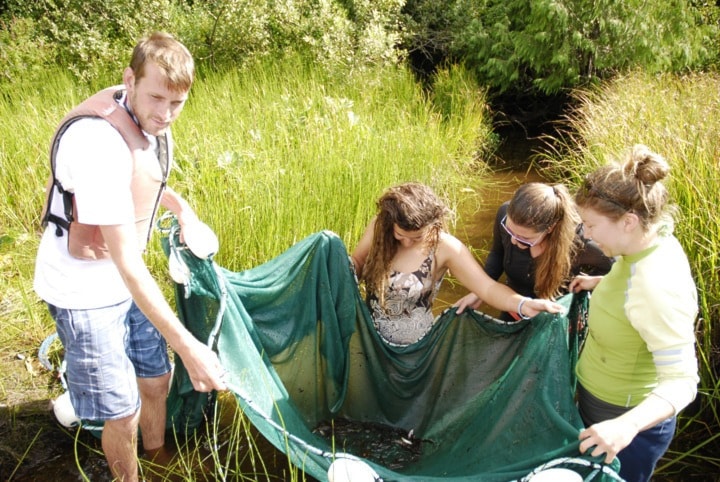For a few days this past August, a group of 14 biology students taking a six week intensive course out at the Bamfield Marine Science Centre got to get their feet wet, so to speak, at the Nitinat River Hatchery, as well as Cheewhat, Hobiton, and Doobah Lakes and some of their tributaries.
The original intent had been for some projects to also be conducted at Nitinat Lake, but due to a boat trailer breakdown, that was no longer possible.
“It was actually a blessing in disguise that whole incident actually. We were going to have one of the student projects be on Nitinat Lake doing studies on shore spawners, like surf smelt that potentially spawn on the shores of Nitinat Lake, which is a tidal lake, and the boat trailer broke on the way,” said instructor Morgan Hocking.
Hocking explains that due to this breakdown, other projects arose through the hatchery, which would not have been possible had the class continued with its original plans.
There were six projects conducted in total, including stream habitat assessment, stream invertebrates, the influence of woody debris in streams, and lake profiling which included looking at oxygen levels, saline profiles, and zooplankton surveys. The two projects that became possible at the Nitinat Hatchery due to the trailer breakdown were comparative morphology between wild and hatchery raised juvenile coho, and analyzing the stomach contents of these same fish and comparing the eating habits of these fish to their morphology.
“And they also did a little experiment in the hatchery itself, where they brought in some zooplankton from the lake to see if the hatchery fish would eat the zooplankton,” said Hocking.
Though Hocking says it is tricky to collect enough data in the short period of time alloted to these students for their field study, for it to be publishable in journals, he says that the goal was to do projects that would be useful as written reports, to the hatchery and to the Ditidaht First Nation.
“The students have to write up reports for the class, and so they will be passing on those reports to both the Ditidaht and to the hatchery,” said Hocking. “But a lot of the reason for doing it is a learning process for the students.”
That’s not to say that Hocking and his students have excluded the idea of writing a publishable paper.
“So this morphology study probably has the greatest chance of being published on its own or be a stand alone interesting piece,” said Hocking. “Because it kind of relates to the wild salmon policy and their [DFO] interest in the resilience of salmon populations and what maintains the resilience and diversity of salmon.”
Sarah Vandenbrink, Jessica Leonard, and Jeff MacAdoms were three of the students involved in conducting the field research, and in particular the research that pertained to the hatchery.
Vandenbrink is studying Environmental Biology at the University of Saskatchewan.
“I really knew nothing about this until I came to Bamfield,” said Vendenbrink. “And I guess Morgan got us really excited about the salmon thing because he’s our salmon guru, pretty much.”
Vandenbrink, along with Leonard, took part in the morphology study, and like Leonard and MacAdoms, Vandenbrink was excited to have taken part in this field research and to have had the opportunity to have the use of the hatchery’s facilities.
“Ours went really well, nothing could go wrong while we were out there,” she said. “It was awesome, it was really fun.”
Leonard is studying at the University of Alberta, and for her the course marked the last class required for her to attain her Animal Biology degree. She says she will be heading home for a few months, but plans on returning to Bamfield in the near future before heading to grad school in 2013.
“I’ve been here all summer, actually,” she said. “I would like to do more, not so much fresh water systems, but something that’s not solely marine. I’m from Alberta so I do enjoy the fresh water systems, but the salmon stuff is really interesting to me.”
MacAdoms was involved with studying the stomach contents of fry used in the morphology study and trying to determine if what the fish were eating correlated with their size and morphology.
“Preliminary analysis suggests that there is quite a big difference. Bigger fish will be eating much more flies and bugs that live on the ground and in the sky as opposed to ones that live on the bottom of the lake.”
MacAdoms, studying biology at UVic, was also excited to have had the opportunity to be involved in field research, and make use of the hatchery.
“Working in the field was a dream. It’s a hot beautiful day, catch a bunch of fish in the net, puke them into a bag, have fun, go camping and canoeing, cook over a fire, that’s a dream,” he said. “Whereas here it’s a bit harder, we’re going cross eyed looking into a microscope.
“We were so lucky to meet Rob at the hatchery, and he offered his space, his expertise, his help, a bunch of their equipment to do what turned out to be probably a way better project.”
Rob Brouwer, the Nitinat Hatchery manager, says that he welcomes any opportunity for student learning, whether it be with Grade 10 and 11 students from Shawnigan Lake who participate regularly with coho and chum intakes, or the yearly groups of university students.
“It gives them something to experiment with,” said Brouwer. “They can collect data and they get the methodology of sampling and reporting.”
For more information on the hatchery and the learning experience it provides students, visit pac.dfo-mpo.gc.ca/sep-pmvs/projects-projets/nitinat/nitinat-eng.htm.
